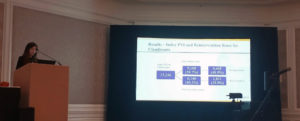
Atherectomy use during index peripheral vascular interventions in claudicants is associated with higher reintervention rates when compared to other technologies, a newly unveiled study by Caitlin Hicks, MD, and colleagues at Johns Hopkins Hospital in Baltimore, Maryland, shows.
The researchers found that 48.9% of those who received an index atherectomy procedure later underwent reintervention, but just 29.8% of patients who did not undergo an initial intervention via an atherectomy did so. Some 59.7% of the study group—drawn from 2019 Medicare data on more than 15,000 patients intervened upon for claudication—received index atherectomy, with the patient pool followed through June 2021.
Comparing reintervention between groups stratified by index procedure, Hicks et al revealed that 85.7% of patients undergoing a first-known intervention with atherectomy also received a reintervention using the same procedure. This compared with just 30.9% among those whose initial intervention was carried out using a different technology.
The data were delivered by Qinqwen Kawaji, MD, a general surgery resident, at the 2022 Southern Association for Vascular Surgery (SAVS) annual meeting held in Manalapan, Florida (Jan. 19–22).
Probing physician side characteristics, the research team also found the estimated 2.5-year cumulative incidence for first-time reintervention was 60% among practitioners deemed high atherectomy users vs. 42.4% in those found to be standard atherectomy users.
After adjusting for all patient characteristics, atherectomy continued to be associated with a 33% higher risk for reintervention, Kawaji told SAVS attendees. “Other characteristics associated with reintervention include Black race, diabetes and urban residence,” she said.
Meanwhile, patients treated initially by high atherectomy user physicians were associated with a 49% increased risk for intervention compared to “first quartile” atherectomy users—with those in quartiles 1–3 being termed “inlier” physicians and those in quartile 4 “outliers.”
Vascular surgeons were associated with associated with a lower risk of reintervention than cardiologists, radiologists, CT surgeons and physicians from other specialties, according to the research team. Other significant physician characteristics associated with reintervention included male sex and high volume peripheral vascular intervention practice, Kawaji said. “Previously, physicians working at ASCs (ambulatory surgery centers) OBLs [office-based labs] have come under scrutiny for atherectomy use,” she added. “In our adjusted model, we did not find an association between site of service and reintervention.”
Kawaji concluded: “Index femoropopliteal atherectomy for claudication is associated with high reintervention rates, and high atherectomy physician users and nonvascular surgeons perform more peripheral vascular reinterventions than their peers. Because of the limitations of our study, we were unable to elucidate whether or not the high reintervention rates were related to atherectomy device failure or physician practice patterns. Our study suggests that appropriateness for atherectomy use in initial peripheral vascular reinterventions for claudication needs critical re-evaluation.”
The analysis builds on previous findings by Hicks and colleagues in recent years. Last year, her group reported on a study of physician practice patterns using the same Medicare dataset in which they found that some 420 physicians, or 25.8%, performed atherectomy in 87.5%-plus of their index femoropopliteal disease intervention cases. Another 133 physicians (8.2%) performed atherectomy in 100% of their index femoropopliteal peripheral vascular intervention cases. They also demonstrated that high users of atherectomy were more frequently cardiologists (38.3% vs. 34.2%) or radiologists (14.1% vs. 6.9%), and less frequently vascular surgeons (34.1% vs. 48.2%).












